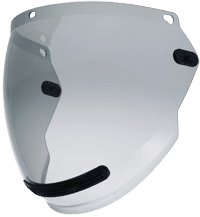A dark tinted face shield and a face shield with a shade rating for IR (infrared) protection are both types of personal protective equipment (PPE) designed to shield the wearer’s face and eyes from various hazards, but they serve different purposes and offer distinct levels of protection.
A dark tinted face shield is primarily used to reduce glare and brightness from intense light sources, such as welding arcs, bright outdoor sunlight, or other high-intensity light applications. A tinted shield is often made from materials that have been treated or coated to absorb or reflect a significant portion of visible light, making the environment more comfortable for the wearer by reducing eye strain and preventing temporary blindness caused by excessive brightness. However, while it provides excellent protection against visible light, it might not necessarily offer the required protection against other hazards like infrared radiation or ultraviolet (UV) rays.

For welding applications, the choice of shade value depends on the specific welding process, the type of materials being welded, the welding current, and the ambient lighting conditions. Different welding processes, such as Shielded Metal Arc Welding (SMAW), Gas Metal Arc Welding (GMAW), and Tungsten Inert Gas (TIG) Welding, emit varying levels of UV and IR radiation. Therefore, welders need to select a shade value that is appropriate for the specific welding operation they are performing.
For example, a shade value of Shade 10 is suitable for less intense welding processes, such as TIG welding, where the arc is relatively dim. On the other hand, higher shade values like Shade 12 or higher may be necessary for more intense processes like arc welding, which produce a brighter and more powerful arc. Using an inadequate shade level can lead to “arc eye” or “welder’s flash”, a painful condition caused by exposure to excessive UV radiation, which feels like having sand in the eyes and can take a day or two to manifest.
However, it’s important to strike a balance between protection and visibility. Darker lenses offer better protection but may hinder the welder’s ability to see their workpiece clearly. Many modern auto-darkening welding helmets have adjustable shade settings that automatically darken when the arc is struck and return to a lighter state when welding stops. This technology provides both optimal protection and visibility, adapting to the changing lighting conditions in real-time. Additionally, flip-front face shields for dynamic work environments, utilizing a clear base face shield and shaded flip-front outer shield, allow the worker to have a clear view for optimal visibility, and shaded protection when engaging in the welding application.
Paulson has been manufacturing world-class face and eye protection for industrial workers for decades. Whether it’s dark tinted face shields for UV and bright light conditions, or our proprietary nanoparticle formulated shaded welding face shields, workers can rely on our face shields to protect them on the job so they can get home safe each day.
For more information on our dark tinted or shaded face shields, please contact us today.


